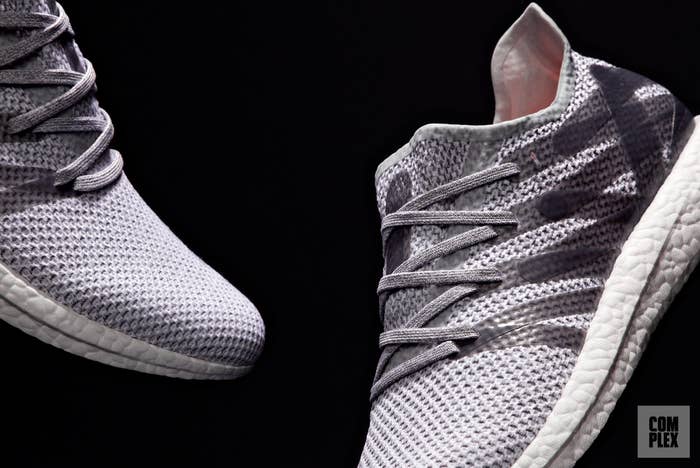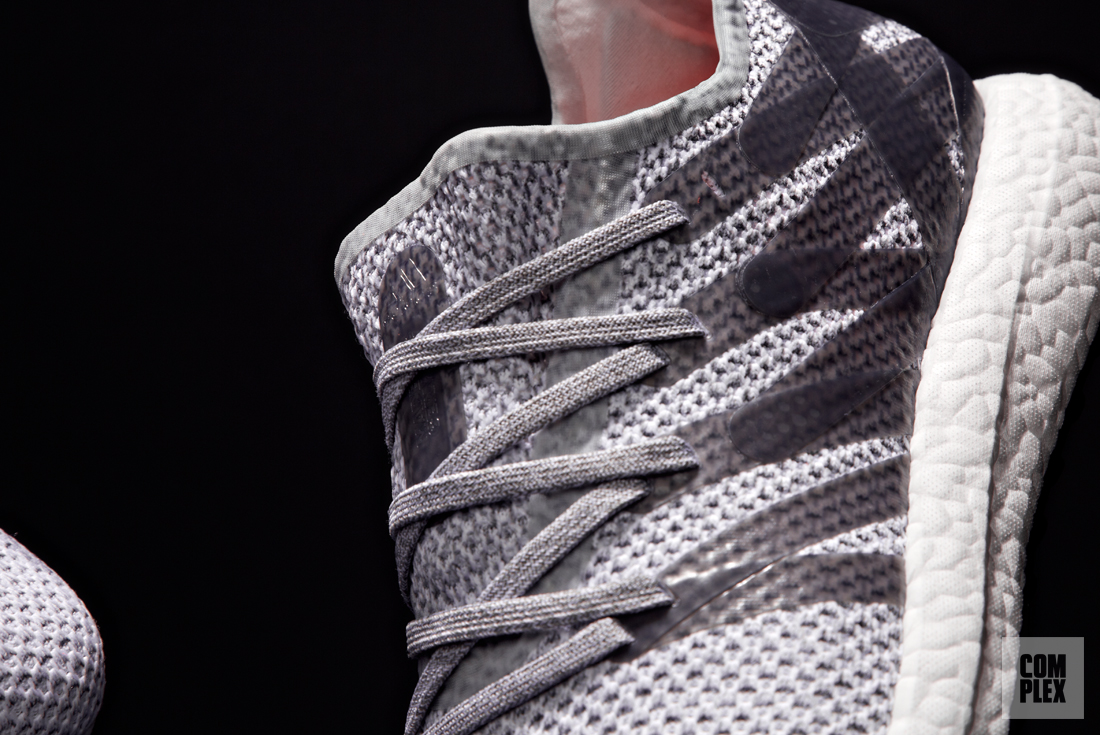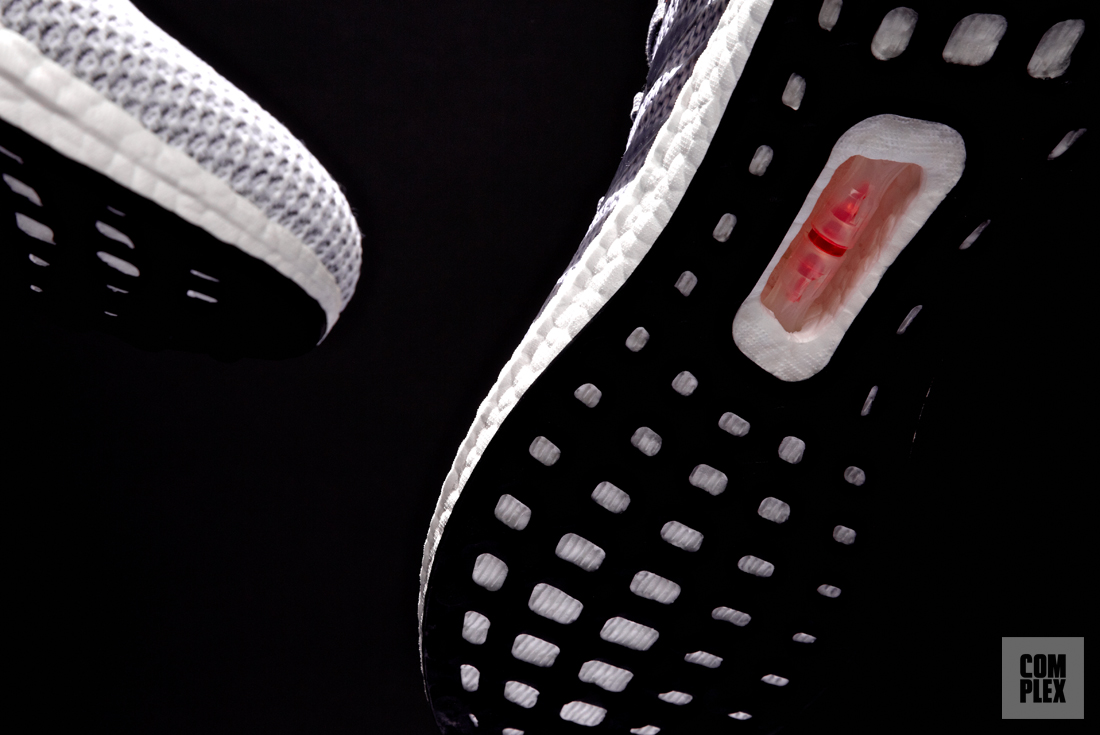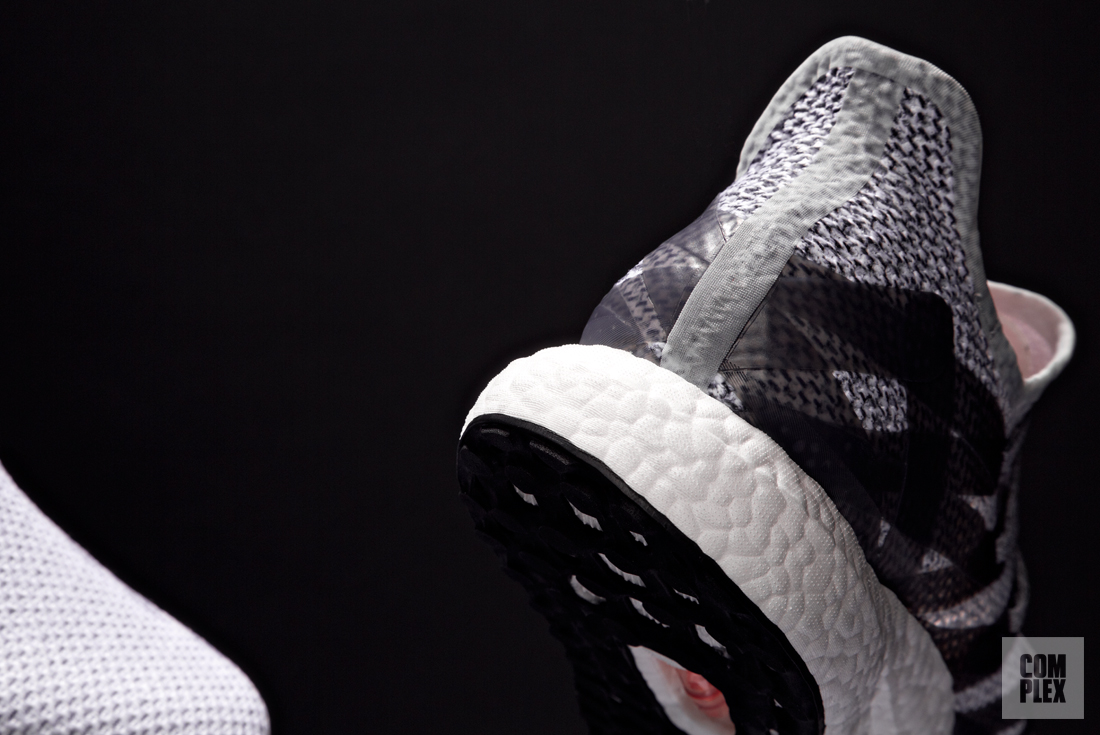
Visions of the future are often represented by robots taking over society, where goods are manufactured by machines rather than people. Adidas is making that a partial reality. The brand’s newest shoe, the Futurecraft M.F.G. (Made for Germany), is leading not only the company into unchartered territory, but the entire sneaker industry.
The MFG is a simple shoe: it has a Boost sole, Primeknit upper, and three stripes across the toe. But what it lacks in loud, boisterous additions it makes up for it with a considered design. There’s an array of “patches” placed on the sneaker to give it the support it needs, and they were put there with intent: The shoe was created with ARAMIS technology, which scans a foot and tells where a shoe needs support and where it doesn’t.
But that’s not even the most revolutionary aspect of the M.F.G., either. It’s made in what Adidas is calling a Speedfactory, a localized center where machines create the sneakers. The shoe looks great, too, but that’s no surprise—it was designed by Adidas vice president of design Ben Herath, the man behind the Ultra Boost and its predecessor, the Ultra Boost Uncaged.
This is truly a watershed moment for sneakers, and it’s only the beginning. We spoke to Herath about not only how he worked on the M.F.G. and the creation of the Speedfactory, but also its impact on footwear moving forward.
(This interview has been edited and condensed for clarity.)
How long did it take to create the Speedfactory?
Speedfactory has been quite a few years in the making now. On the design side, we came on board three years ago, but the idea and the strategy has been in place for quite a while. It’s the result of a huge team working on this, with design being an element of that.

And the M.F.G.?
We’ve been working on this for two years. The whole process behind the way that it’s made means we can turn designs around really quickly. We’ve been prototyping and editing the process almost weekly at the moment. The ability of the new production line allows to speed the whole creation process up. We’ve been working on the design for quite awhile, but we’ve been able to turn around quite a few prototypes based on that.
How big of a role did the ARAMIS technology play in the design of the M.F.G.?
Quite a lot. We wanted this design to represent the science of what we know. It’s a design that’s driven by analytics and what we could see from the ARAMIS technology. What that did was let us see where the foot was moving when you run, where it needed to support, where it needed to move. We were able to place these patches precisely where we needed them. The whole approach to the shoe is about creating the ultimate fit. I think we’ve tried to do that by letting the science define the design of the shoe.
Do you think running sneakers, as a whole, are moving towards the “Uncaged” design?
We’re always trying to improve the experience and fit of running shoes. When I was working on the Ultra Boost, that became the benchmark that we measured every shoe against. With the Uncaged, we found another experience thereby removing the cage and really putting the support on the inside. With this patch placement, it’s another way of providing the almost tailored support around the foot. For me, these are all ways of providing a new experience for the runner.

Is there more Boost in this shoe?
We’ve really dug down into the construction of the shoe to remove the layers between your foot and the Boost foam. What you’re feeling is the sensation of more Boost. We did that by removing a lot of layers that you find in an Ultra Boost.
Are there any special details on this shoe?
If you could strip apart all of the ingredients, we’ve pushed everything as far as we could that could be made through this production line, from the Primeknit to the patch placement to how we make the midsole. There are a lot of small innovations that have gone through to create this new design using all these new machines that can be made in a factory that’s in Germany. That meant partnerships with a lot of companies to make sure what we’re doing is going to live up to the expectations we have around a high-performance running shoe. It is also required us to learn more about these new machines. How could we build the same fit and support that people expect but within a radically new production line? That was quite a revolutionary experience.
The shoe is made for high-performance running, but it also looks great. Do you focus on one over the other?
The two are intertwined, you can’t speak performance without style or talk about experience without expression. They go hand in hand. The approach here at Adidas is to be daringly simple. For us, that means we’re constantly pushing ourselves to be more simple in our designs and more honest in how they’re made; to let the materials and constructions showcase the beauty of the designs. When you aim to do that, you start to see the natural beauty come out in the shoe, the materials, and how color gets used on the shoe. It’s about authentic to the purpose of the shoe and letting the construction and the design be the hero of the shoe; not try to over-stylize or design the shoe. It should naturally be there. That approach isn’t easy, trying to simplify a product down to its bare minimum. That’s when products transcend beyond the sport and people admire them for more than what they’re built for.

Is there going to be more pairs of the Futurecraft M.F.G.?
This design is a 1/500 that we’ve been launching in small doses around Berlin. That was the first production run. The plan is ambitious behind this Speedfactory. We’re going to start to scale up the volumes in the production of this to make it more accessible. We’re excited by the flexibility in the production line that we’re able to program the machines to adjust designs as well. We’re not just bringing production to people, we’re bringing the process as well. We’ll be able to co-create designs with people depending on what they need, what they want, what type of running style they have, what type of support they need. We can tailor a design for them.
Is this going to make it so sneakers can be customized on the spot?
We’re excited by the potential for what this can mean for the whole industry. We’re changing how shoes are made by bringing them closer to the consumer and the time it takes to make a shoe. Usually it’s about 80 months, and we’re bringing that down to days and almost hours. Right now the focus is on running, and we’re using running as the key vehicle to show the potential of what this Speedfactory can do.
Is this the biggest thing you’ve ever done for Adidas?
Yes, which is hard to say. I’d like to think I’m working on the forefront of what we can do here. Last year was the Ultra Boost and I was so proud of that shoe, for what that shoe meant for running and what we can do at Adidas. Now with the Uncaged and the MFG, I’m super excited about what this means for the future of Adidas. I’m excited about this project what it means.

Will 3D printing be included in the Speedfactories?
This is one of the chapters in our Futurecraft story. 3D printing, Tailored Fibre, Milled leather, they’re all processes using new machines and pioneering our field. For us, we’re excited by combining those new technologies with Speedfactory. I can’t say too much other than, “Stay tuned.”
Is this going to make shoes cheaper and less-expensive to make in the future?
At the moment, the first shoes were 250 euros. That’s quite expensive, because it’s a new technology that we’ve invested in. The ambitions are that we’re going to scale this so it’s reachable and accessible as well. That’s our hope that with Speedfactory, we’re not just bringing new innovation and co-creating with consumers, but we’re making production of shoes accessible with them, and that’s also with price.
What’s next?
The next step is to open a Speedfactory in Atlanta. That’s step two in this, and we’re happy about bringing shoe manufacturing to Atlanta. We’re still looking into our plans about where next. We want to open new locations across the globe.

